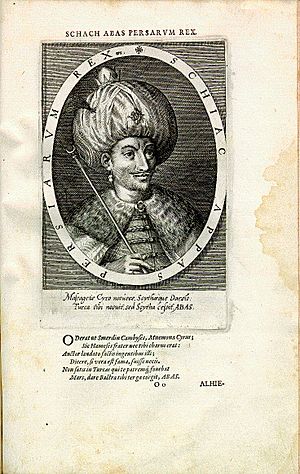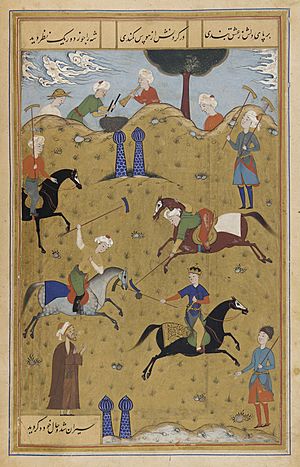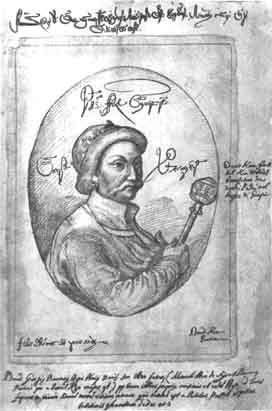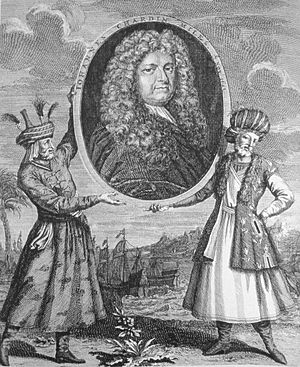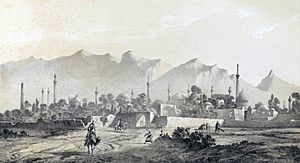Safavid Iran facts for kids
Quick facts for kids
Safavid Empire
|
|||||||||||||||||||||||||||||
|---|---|---|---|---|---|---|---|---|---|---|---|---|---|---|---|---|---|---|---|---|---|---|---|---|---|---|---|---|---|
| 1501–1736 | |||||||||||||||||||||||||||||
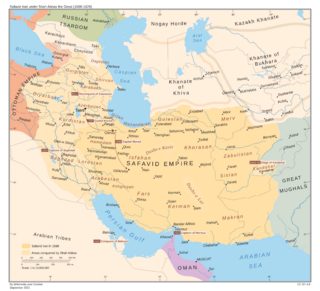
The Safavid Empire under Shah Abbas the Great
|
|||||||||||||||||||||||||||||
| Status | Empire | ||||||||||||||||||||||||||||
| Capital | |||||||||||||||||||||||||||||
| Common languages |
|
||||||||||||||||||||||||||||
| Religion | Twelver Shīʿa Islam (official) | ||||||||||||||||||||||||||||
| Government | Monarchy | ||||||||||||||||||||||||||||
| Shahanshah | |||||||||||||||||||||||||||||
|
• 1501–1524
|
Ismail I (first) | ||||||||||||||||||||||||||||
|
• 1732–1736
|
Abbas III (last) | ||||||||||||||||||||||||||||
| Grand Vizier | |||||||||||||||||||||||||||||
|
• 1501–1507
|
Amir Zakariya (first) | ||||||||||||||||||||||||||||
|
• 1729–1736
|
Nader Qoli Beg (last) | ||||||||||||||||||||||||||||
| Legislature | Council of State | ||||||||||||||||||||||||||||
| Historical era | Early modern period | ||||||||||||||||||||||||||||
|
• Establishment of the Safavid order by Safi-ad-din Ardabili
|
1301 | ||||||||||||||||||||||||||||
|
• Established
|
22 December 1501 | ||||||||||||||||||||||||||||
|
• Hotak invasion
|
1722 | ||||||||||||||||||||||||||||
|
• Reconquest under Nader Shah
|
1726–1729 | ||||||||||||||||||||||||||||
|
• Disestablished
|
8 March 1736 | ||||||||||||||||||||||||||||
|
• Nader Shah crowned
|
8 March 1736 | ||||||||||||||||||||||||||||
| Area | |||||||||||||||||||||||||||||
| 1630 | 2,900,000 km2 (1,100,000 sq mi) | ||||||||||||||||||||||||||||
| Currency | Tuman, Abbasi (incl. Abazi), Shahi
|
||||||||||||||||||||||||||||
|
|||||||||||||||||||||||||||||
|
State religion.
Official language, coinage, civil administration, court (since Isfahan became capital), literary, theological discourse, diplomatic correspondence, historiography, court-based religious posts. Court, religious dignitaries, military, mother tongue, poetry. Court. |
|||||||||||||||||||||||||||||
The Safavid Empire was one of the most important empires in Iran's history. It was ruled by the Safavid dynasty from 1501 to 1736. Many historians see it as the start of modern Iranian history. It was also one of the "gunpowder empires" because it used new military technologies like cannons.
The Safavid ruler, Ismail I, made Shia Islam the official religion of the empire. This was a huge change in the history of Islam. The Safavids were originally a Sufi group. They grew to control a large area, including all of modern-day Iran, Azerbaijan, Armenia, and parts of other countries.
Even after the empire ended, the Safavids left a big mark. They helped Iran become a strong economic link between the East and West. They also created a good government system. Their art and buildings were amazing. Most importantly, they made Shia Islam the main religion in Iran and spread it across the Middle East.
Contents
- How the Safavid Empire Started
- The Rise of Shah Ismail I
- Shah Tahmasp's Reign (1524–1576)
- Chaos After Tahmasp's Death
- Shah Abbas the Great (1588–1629)
- Decline of the Empire
- Society and Culture
- Religion in the Safavid Empire
- Government Structure
- Economy and Trade
- Culture and Art
- Languages of the Empire
- Legacy of the Safavids
- See also
How the Safavid Empire Started
The Safavid story began with a Sufi group called the Safaviyya. It was founded by Safi-ad-din Ardabili in 1301. This group became very popular in the city of Ardabil.
Over time, the Safaviyya leaders became more interested in power. One leader, Shaykh Junayd, wanted to rule. He married into a powerful family called the Aq Qoyunlu. Junayd was killed in battle, and his son Haydar Safavi took over.
Haydar also married into the Aq Qoyunlu family. His son was Ismail I, who would later found the Safavid dynasty. The Safaviyya followers were mostly Oghuz Turks. They were known as Qizilbash ("Red Heads") because of their special red hats. These Qizilbash warriors were very loyal to Haydar and his family. They became the main military power for the Safavids.
After Haydar's death, his young son Ismail became the leader.
The Rise of Shah Ismail I
Before Ismail I, Iran was split into many small states. Different religious groups and rulers fought for control. Ismail I managed to unite these lands.
In 1500, Ismail I attacked Shirvan to get revenge for his father's death. In 1501, he captured Tabriz. There, he declared himself "Shah" (King) of Iran. He made Twelver Shia Islam the official religion. This was a very important moment for Iran.
Ismail I quickly expanded his empire. Within 10 years, he controlled most of Iran. He also made the kingdoms of Kartli and Kakheti in Georgia his vassals. By 1511, he pushed back the Uzbeks in the northeast. This secured Iran's eastern borders.
Fighting the Ottoman Empire
The Safavids faced a powerful enemy: the Ottoman Empire. The Ottomans were Sunni Muslims. They saw the Safavids' growing power and their Shia beliefs as a threat.
In 1514, the Ottoman Sultan Selim I attacked the Safavids. The two armies met at the Battle of Chaldiran. The Ottomans had more soldiers and cannons, which the Safavids lacked. Ismail I was defeated, and his capital, Tabriz, was captured.
Even though they lost, the Safavid Empire survived. This battle started a long period of wars between the Ottomans and Safavids. These wars were about land and different religious beliefs. The defeat at Chaldiran also changed Ismail I. He stopped leading the government directly and let his officials handle things.
Shah Tahmasp's Reign (1524–1576)

Shāh Tahmāsp became ruler in 1524 when he was only ten years old. At first, powerful Qizilbash leaders tried to control him. This led to fighting among the Qizilbash tribes for about 10 years.
Tahmasp eventually took control. He decided to rely on Persian officials instead of just the Qizilbash.
Threats to the Empire
During Tahmasp's rule, the Uzbeks attacked Iran's eastern lands five times. The Ottomans, led by Suleiman the Magnificent, invaded Iran four times.
Tahmasp avoided direct battles with the Ottomans. Instead, he used a "scorched earth" tactic, destroying land so the enemy couldn't use it. In 1555, he signed the Peace of Amasya with the Ottomans. This treaty ended the war for 20 years. It meant Iran lost some land, but it saved the empire.
Royal Guests
Tahmasp's court became a safe place for other rulers in trouble.
- Humayun, the Mughal emperor from India, fled to Tahmasp's court in 1543. Tahmasp helped him regain his empire in exchange for the city of Kandahar.
- Şehzade Bayezid, a son of Ottoman Sultan Suleiman, also sought refuge in Iran in 1559. Tahmasp eventually handed him over to his father, who had him killed.
Tahmasp's Achievements
Tahmasp ruled for a long time. He kept the empire together despite civil wars and foreign attacks. He strengthened the central army. He also supported the arts, especially persian miniature painting and book-binding.
Tahmasp also started a big change in the Safavid army. He began bringing in Christian slaves from the Caucasus region, like Circassians and Georgians. These slaves, called ghulams, were trained as soldiers. They were loyal only to the Shah, not to any tribe. This helped reduce the power of the Qizilbash. Many Caucasian women also became part of the royal household.
Chaos After Tahmasp's Death
When Tahmasp died in 1576, there was a fight for the throne. His son Ismail II became Shah.
Ismail II's Short Rule (1576–1577)
Ismail II ruled for only 14 months. He had many of his relatives killed to prevent rivals. He also tried to change the official religion back to Sunni Islam. He was eventually killed, possibly by his half-sister.
Mohammad Khodabanda's Rule (1578–1587)
Mohammad Khodabanda, Ismail II's nearly blind brother, became the next Shah. He was not a strong ruler. His sister and then his wife tried to control the government. This led to more fighting among the Qizilbash.
During this time, the Uzbeks and Ottomans attacked Iran again. The Ottomans took over parts of Georgia and Shirvan, and even captured Tabriz. Mohammad's son, Abbas, started a rebellion in the east. The empire was in great danger.
In 1588, Mohammad Khodabanda gave up his throne to his son, Abbas.
Shah Abbas the Great (1588–1629)
Shah Abbas became ruler at 16. At first, a powerful Qizilbash leader tried to control him. But Abbas quickly showed he was a strong leader. He had his "mentor" killed and made it clear he was in charge.
Abbas had a plan to save the empire: 1. Make the country safe and orderly. 2. Get back lands lost to the Uzbeks. 3. Get back lands lost to the Ottomans.
He made a peace deal with the Ottomans, giving them some land for now. This bought him time to fix things inside Iran.
Strengthening the Government and Army
Abbas changed how the empire was run. He took control of more provinces directly, which meant more money for the Shah. This money helped him build a new army loyal only to him.
This new army was made up of:
- Shahsevans: Qizilbash who swore loyalty only to the Shah.
- Ghulams: Thousands of Christian slaves from the Caucasus (Georgians, Circassians, Armenians). They were trained as elite soldiers and government officials. They were loyal only to the Shah.
- Musketeers: A large group of soldiers armed with guns.
- Artillery Corps: Soldiers who used cannons.
This new army, especially the ghulams, greatly reduced the power of the Qizilbash tribal leaders. Abbas also moved the capital to Isfahan, a central city in Iran. This made the government more Persian in character.
Winning Back Land
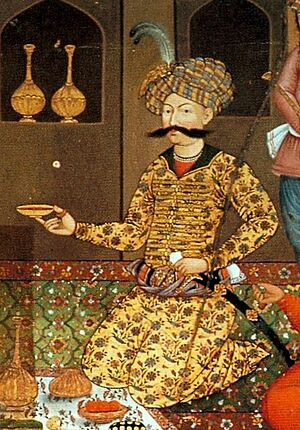
Shah Abbas first fought the Uzbeks, taking back Herat and Mashhad in 1598. Then, he turned to the Ottomans. He won major victories and recaptured Baghdad, eastern Iraq, and the Caucasus regions by 1616. This was a huge success against Iran's old enemy.
He also drove the Portuguese out of Bahrain (1602) and Hormuz (1622) in the Persian Gulf with help from the English. This helped Iran control important trade routes.
Dealing with Rebellions
Abbas also put down rebellions. In 1614–1616, he crushed a revolt in Georgia. He deported many Georgians to central Iran to ensure loyalty. He also suppressed a Kurdish rebellion in 1609–1610.
Contacts with Europe
Abbas wanted to make friends with European countries. He hoped they would help him fight the Ottomans. He sent his first diplomatic mission to Europe in 1599. They visited many countries, including Italy and Spain.
Abbas was very open to Christians. He even said he preferred "the dust from the shoe soles of the lowest Christian to the highest Ottoman personage." He offered trade deals and allowed Christian missionaries in Iran.
His contacts with the English were very helpful. English adventurers like the Shirley brothers helped Abbas improve his army. English ships also helped him take back Hormuz from the Portuguese.
Abbas I's Legacy
Shah Abbas was a very strong and effective ruler. He made the Safavid Empire powerful and stable. He centralized the government and created a strong, loyal army. He also made Iran a center for art and culture.
However, he was also very suspicious. He had his own sons killed or blinded because he feared they would try to take his throne. When he died in 1629, he had no son left to take over.
Decline of the Empire

After Shah Abbas I, the Safavid rulers were not as strong. The empire faced new challenges. Russia expanded its power towards the Caucasus. The Mughals in India took some eastern lands, like Kandahar.
The Dutch East India Company and the English used their strong navies to control trade routes. This cut Iran off from some overseas trade.
Later shahs, like Soltan Hoseyn (1694–1722), were not interested in ruling. They lived lavish lifestyles while the empire weakened.
The Afghan Invasion
In the early 1700s, the empire was raided on its borders. Sultan Hoseyn tried to force his Afghan subjects in Qandahar to change their religion. This led to a rebellion.
In 1722, an Afghan army led by Mir Mahmud Hotaki attacked the heart of the empire. They defeated the Safavid forces and besieged the capital, Isfahan. Shah Soltan Hoseyn gave up his throne, and Mahmud became the new king of Iran.
At the same time, Peter the Great of Russia attacked northern Iran. The Ottomans also invaded western Iran. Russia and the Ottomans agreed to divide the conquered Iranian lands between them.
Nader Shah and the End of the Safavids
The Afghans ruled for seven years. But then, a brilliant military leader named Nader Shah emerged. He was from the Afshar tribe. Nader Shah quickly defeated the Afghans and drove them out of Iran by 1729.
He also made deals with Russia to get back lost territories in the Caucasus. He then fought the Ottomans and took back all the lands they had seized.
Nader Shah had full control over the Safavid rulers. In 1736, he crowned himself Shah, officially ending the Safavid dynasty.
After Nader Shah's death in 1747, the Safavids were briefly put back on the throne as puppet rulers. But this ended in 1760, and the Safavid dynasty was finally over.
Society and Culture
The Safavid Empire had a population of about 8 to 10 million people in 1650. It was a meritocracy, meaning people were chosen for jobs based on their skills, not their birth. This prevented a fixed noble class.
The Shah was at the top of society. Below him were nobles, religious leaders, merchants, and farmers. Religious leaders often helped protect ordinary people from harsh rulers.
Daily Life and Customs
A French traveler named Jean Chardin wrote a lot about Iranian culture in the 1600s. He admired their kindness to foreigners.
Iranians at the time enjoyed relaxing and luxury. They liked activities that kept them fit for fighting, like archery, fencing, and horsemanship. Hunting was also very popular.
Entertainment
Wrestling was a very old and important sport in Iran. Professional wrestlers, called Pahlavans, were respected. Towns had their own wrestling teams.
People also enjoyed watching fencing, tightrope walkers, puppet shows, and acrobats in big squares. Cabarets were places to relax, drink, smoke, and listen to poetry.
Clothes and Appearance
Iranians loved luxury and looking good. They decorated their clothes with jewels. Men wore many rings and jewels on their arms. Daggers were worn at the waist.
Women's clothes showed more of their figure than European clothes. At home, they wore light veils. In public, they wore large cloaks that covered most of their bodies, except their faces. They often dyed their hands and feet with henna.
The turban was a very important accessory for men. Men of status changed their turbans often. Clothes were changed immediately if they got dirty.
Groups in Society
Safavid society had two main groups:
- Turkic-speaking military elite: These were the "men of the sword" like the Qizilbash. They kept the empire safe.
- Persian-speaking administrative elite: These were the "men of the pen." They ran the government and developed the country.
This mix of Turkic and Persian cultures was common in many empires that ruled Iran. The two groups needed each other, but there was some rivalry.
The Caucasian "Third Force"
Starting with Shah Tahmasp, a new group was added to society: ethnic Caucasians. Shah Abbas I greatly expanded this idea.
The Shahs wanted to reduce the power of the Qizilbash tribes. So, they brought in hundreds of thousands of Christian Georgians, Circassians, and Armenians as slaves or deportees. These people converted to Islam.
These Caucasians became the "third force" in Iranian society. They were loyal only to the Shah. Many became ghulams (royal slaves) who served in the army or government. They were not tied to tribal loyalties like the Qizilbash. Many Caucasian women also became wives and concubines in the royal harem.
By 1595, a Georgian named Allahverdi Khan became one of the most powerful men in the Safavid state. This shows how important the Caucasians became.
Religion in the Safavid Empire
The Safavids made Shia Islam the official religion of Iran. Before them, Iran had many Sunni Muslims. Ismail I made conversion to Shia Islam mandatory. Sunni religious leaders were either killed or sent away. Shia leaders were brought in and given land and money.
Over time, the power of the Shia religious scholars (called ulama) grew. They became very influential in society.
Religious Scholars and Merchants
An important link formed between the ulama and the merchant community. Many landowners gave their lands to the clergy as vaqf (religious endowments). This protected their land from being taken by the government. In return, a part of the income from the land went to the ulama. This made the religious class a new group of powerful landowners.
Government Structure
The Safavid government had a system of checks and balances. The Shah had total power, but there were rules and officials to prevent fraud. Every official had a deputy who reported directly to the Shah.
Government Officials
The highest official was the Prime Minister (Grand Vizier). He had huge power and was the Shah's main deputy. No action of the Shah was valid without his seal.
Other important officials included:
- General of the Revenues: The finance minister.
- Divanbegi: The Minister of Justice, who handled civil and criminal cases.
- Generals: Leaders of the different army branches.
The Royal Court
The Nazir was the Court Minister and perhaps the Shah's closest advisor. He managed the royal household and the Shah's properties.
Other court officials included:
- Grand Steward: Always with the Shah, introducing guests and receiving petitions.
- Master of the Royal Stables: Managed the Shah's many horses.
- Master of the Hunt: Organized hunting expeditions.
Doctors and astrologers were highly respected. The Chief Physician and Chief Astrologer were important members of the court.
The court was a mix of people: Turkoman Qizilbash nobles, Persians who ran the government, and the new Caucasian ghulams (Georgians, Circassians, Armenians). Many different languages were spoken, including Azerbaijani, Persian, Georgian, Circassian, and Armenian.
Local Government
Local areas were ruled by governors, often Qizilbash generals. They acted like small kings, keeping most of the money from their provinces. In return, they had to provide soldiers to the Shah.
Shah Abbas I tried to take more land under his direct control to increase royal income. This meant local commissioners, who cared more about money than the people, replaced governors. This sometimes made life harder for ordinary people.
Law and Justice
Safavid law combined religious law (sharia) and traditional law (urf). Religious judges handled civil law, while secular officials handled traditional law and criminal cases.
The Minister of Justice was the highest legal authority. Lesser officials, like the qazi, acted as judges in the provinces.
Criminal justice was separate. Murder was punishable by death. Robbers had their hands cut off for a first offense.
Economy and Trade
The Safavid economy grew because of stability. Agriculture thrived, and trade was strong due to Iran's location between Europe, India, and Central Asia. The Silk Road was very important for trade.
Shah Abbas I encouraged trade with Europe, especially England and the Netherlands. Iran exported carpets, silk, textiles, horses, and pearls. Imports included spices, textiles, metals, coffee, and sugar.
In the late 1600s, Iran had a higher standard of living than many parts of Europe. Farmers, for example, lived very comfortably.
Agriculture
Farming and raising animals were the main parts of the economy. Iran grew many fruits and vegetables, some unknown in Europe. Tobacco and saffron were also important crops.
However, much fertile land was not used. This was due to poor management and a small population. Farmers shared their crops with landlords. They generally lived well, but sometimes had to do forced labor.
Travel and Caravanserais
Horses, mules, and camels were used for travel. The best horses came from Arabia and Central Asia.
Traveling in Iran was easy because of good roads and many caravanserais (roadside inns). These inns were well-built and clean. They were free for travelers, especially poorer ones. Shah Abbas I built many new caravanserais and bridges to improve trade routes. Road guards collected tolls and kept travelers safe.
Foreign Trade
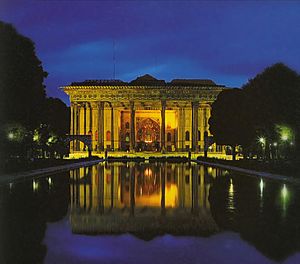
The discovery of sea routes around Africa by the Portuguese hurt the Silk Road trade. Shah Abbas I drove the Portuguese out of the Persian Gulf with British help. This opened up trade with the British and Dutch.
The Safavids also had influence in India, especially in the Deccan region. Persian traders also went to Southeast Asia.
However, land trade remained more important than sea trade for Iran. Most of the government's money came from taxes on goods passing through the country. Shah Abbas wanted to expand this trade, especially with Europe, by using routes that avoided Ottoman territory.
By the end of the 1600s, the Dutch became dominant in Persian Gulf trade. Competition from other countries led to a decline in the Safavid economy.
Culture and Art
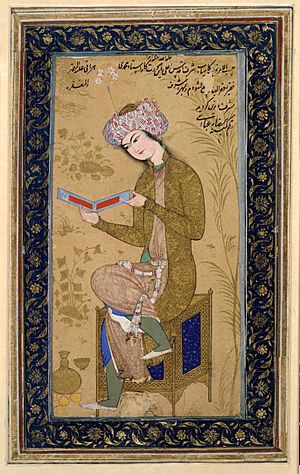
Shah Abbas I encouraged the arts because they were good for trade. Handicrafts like tile making, pottery, and textiles grew. Miniature painting, bookbinding, and calligraphy also became very popular. Carpet weaving became a major industry, with Tabriz as its center.
Artists like Reza Abbasi created new styles of Persian painting. Iranian artists also learned from European art. Famous books like the Shahnameh (Book of Kings) had beautiful illustrations.
Architecture
Isfahan has the most famous Safavid buildings. When Shah Abbas moved the capital there in 1598, he started a huge building project. He wanted to make Isfahan a grand capital and centralize power.
The main architect was Shaykh Bahai. He designed the Chahar Bagh avenue and the amazing Naqsh-e Jahan Square. This square brought together the power of the clergy (with the Shah mosque), merchants (with the Imperial Bazaar), and the Shah (with the Ali Qapu Palace).
Other famous buildings include the Sheikh Lotf Allah Mosque and the Hasht Behesht palace. Safavid architecture was rooted in Persian culture and influenced later periods.
Literature and Philosophy
Poetry was not as strong during the Safavid period. However, historians like Iskandar Beg Munshi wrote important works, such as his History of Shah Abbas the Great.
Islamic philosophy thrived in the Safavid era, especially in Isfahan. Scholars like Mir Damad and Mulla Sadra were very influential. Mulla Sadra's ideas combined Sufi mysticism, Shia theology, and other philosophies.
Medicine
Doctors were highly respected in Safavid Iran. They were often advisors to the Shahs. Medicine still relied on ancient and medieval knowledge. The works of earlier Persian doctors like al-Razi and Avicenna were still used as textbooks.
Some progress was made in pharmacology, with new books on medicines.
Languages of the Empire
The Safavid rulers originally spoke Azerbaijani. This was the main language at the court and in the military. However, Persian was the official language of the empire. It was used for government, writing, literature, and history. Coins also had Persian inscriptions.
Many people at court, especially the Turkoman nobles, also spoke Persian. But most Persians did not speak Azerbaijani.
Because of the many Georgians, Circassians, and Armenians at court, their languages were also spoken. Shah Abbas himself could speak Georgian.
Legacy of the Safavids
The Safavids had a huge impact on modern Iran.
- They made Iran the main center of Shia Islam.
- They kept many old Persian traditions alive.
- They started a struggle for power between religious leaders and the government.
- They created a strong link between religious classes and merchants, which was important in later revolutions.
- Shah Abbas I created a more centralized government system.
The Safavid Empire helped create a recognizable early version of modern Iran. It left behind many government features and connected religious and land boundaries that are still important today.
See also
 In Spanish: Imperio safávida para niños
In Spanish: Imperio safávida para niños
- Persianate states
- List of Shi'a Muslim dynasties
- Safavid conversion of Iran to Shia Islam
- Khanates of the Caucasus




